LAW & ORDER: SPECIAL VICTIMS UNIT Vet Neal Baer Looks Back on Season 12: ‘Locum,’ ‘Bullseye,’ ‘Behave,’ and ‘Merchandise’
September 16, 2024 by Marisa Roffman
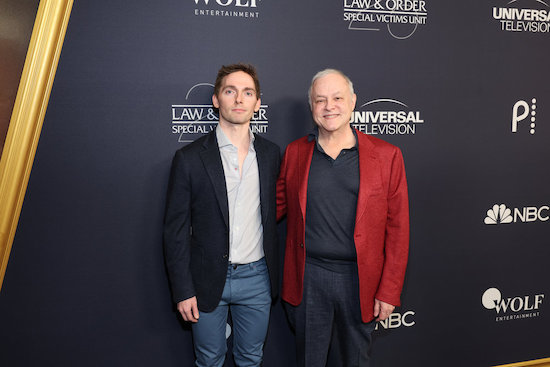
LAW & ORDER: SPECIAL VICTIMS UNIT — “Season 25 Anniversary Party” — Pictured: (l-r) Grant Schleifer, Neal Baer at Edge at Hudson Yards on January 16, 2024 — (Photo by: Cindy Ord/NBC)
For nearly 25 years, LAW & ORDER: SPECIAL VICTIMS UNIT has been a television institution. Debuting on Monday, September 20, 1999, the Dick Wolf-created series has aired over 550 episodes (and counting), as members of the Special Victims Unit fought for justice on behalf of survivors of sexual assault, domestic abuse, and other sensitive topics.
Throughout the show’s 25 seasons, there have been hundreds of cases, nearly two dozen series regulars (Mariska Hargitay is the sole original series regular to remain with the show in every season; her former co-lead, Christopher Meloni, now stars in the SVU spinoff ORGANIZED CRIME), and variations of how the writers showcased their stories. (Season 1, for instance, leaned more heavily into the characters’ personal lives; season 25 had a case that lasted for the duration intermingled with standalone cases.)
But, arguably, season 12 (which aired from 2010-2011) was the most structurally complex batch of episodes the show has done thus far. Though the series had flirted with arcs in the past—including Stabler’s divorce and eventual reconciliation with his wife, Benson’s temporary hiatus from the squad (twice), plus, her PTSD from a traumatic close call on the job—the 24-episode season had multiple arcs (personal and professional), the series had crossovers with sister series LAW & ORDER: LOS ANGELES, a couple of recurring characters were brought back and killed off, and a season 7 case was brought back in an unusual way.
Of course, it marked the end of an era in many ways, too: Longtime showrunner Neal Baer announced his intention to exit when season 12 wrapped. (Baer, who took over as showrunner in mid-season 2, remains the longest-tenured showrunner in the show’s 25-year history.) During the hiatus between seasons 12 and 13, it was announced that Meloni wouldn’t be returning and long-time regulars BD Wong and Tamara Tunie were also exiting. (Season 12 was also the final time, so far, the series received Primetime Emmy acknowledgment, with Hargitay scoring her eighth consecutive Outstanding Lead Actress in a Drama Series nomination; she won the category in 2006.)
With Baer aware he would be leaving at the end of the season—to move to CBS, where he ran A GIFTED MAN and UNDER THE DOME—he intentionally embraced the show’s (and his own) past. “It was bringing back people I really like,” he says of the roster, which included SVU vets Marcia Gay Harden, Gloria Reuben (whom he knew from ER), and Christine Lahti, as well as ER vets like Maria Bello. “I was like, Okay, I’ve done [SVU] for 11 years, probably it’s time to move on…I mean, my gosh, I had spent 18 years at NBC: seven on ER and 11 on SVU….But it’s always fun to work with folks again.”
Here, Baer—who recently released a book, THE PROMISE AND PERIL OF CRISPR, and is also teaching Master of Science in Media, Medicine, and Health at the Harvard Medical School graduate program (in addition to developing new shows and teaching how to write character-centric procedural shows)—breaks down the first few episodes of LAW & ORDER: SPECIAL VICTIMS UNTIL season 12. (And check back tomorrow for more episodes.)
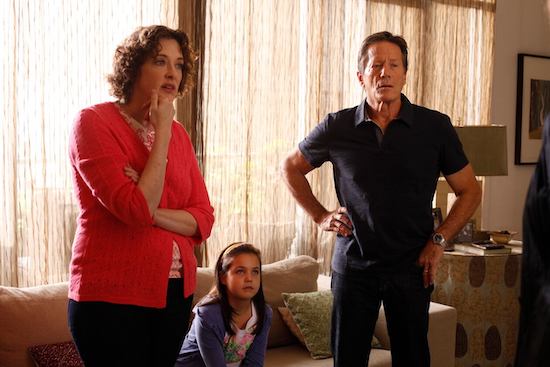
Joan Cusack, Bailee Madison, and Peter Strauss in “Locum.” (Credit: NBC.)
“Locum” (Written by: Dawn DeNoon; Directed by: Arthur W. Forney): The season kicked off with a two-episode block; the first hour focused on the disappearance of a young adopted girl, Mackenzie (portrayed by Bailee Madison). But when Benson (Hargitay) and Stabler (Meloni) were brought in, her parents (played by Joan Cusack and Peter Strauss) were worried the same person who kidnapped their first daughter, Ella (who was still missing), might have returned.
Mackenzie, distraught over how her new parents had tried to model her into the daughter they lost, actually ran away…but it set two things in motion: An introduction to Henry Ian Cusick’s Erik Weber, a suspect in Mackenzie’s “kidnapping,” who the cops realized was an overeager vigilante as a member of COAP (Citizens Organized Against Predators); plus, Benson and Stabler being on the case meant they were able to find a still-alive Ella and reunite her with her parents.
“Who doesn’t want to work with Joan Cusack and Peter Strauss?” Baer notes. “I would go to [casting director] Jonathan Strauss and say, ‘I really see this person. I’d love to have Peter Strauss on. Can we get Joan Cusack? We can write them.’”
Cusack’s Pamela was especially despondent and struggling with her trauma over Ella’s disappearance. “Joan Cusack is so emotional and so real,” Baer enthuses. “In the bathtub [in the cold open when Mackenzie disappears], and she can’t get out, get the door open…she’s so kind of kooky [in being overbearing about her new daughter], but you believe it.”
And then when Ella is reunited with her parents—and Mackenzie stoically watches from afar—”So intense,” Baer gushes. “Oh my goodness, so great. There’s so much great acting in these episodes, that’s for sure.”
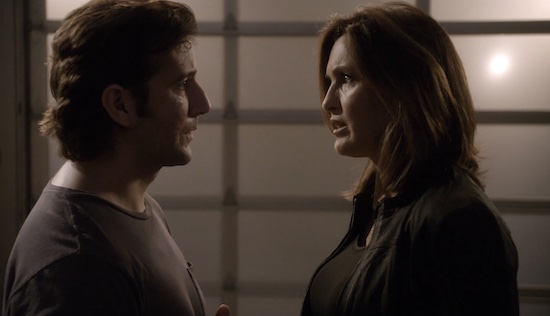
Henry Ian Cusick and Mariska Hargitay in “Bullseye.” (Photo credit: Screencap/NBC.)
“Bullseye” (Written by: Daniel Truly; Directed by: Peter Leto): In the second hour of the premiere event, young girls were brutally raped, leading Benson and Stabler to seek out Cusick’s Erik in the hopes his group might have insight into their suspect.
“There’s a bit of a flirtation, certainly from Erik Weber’s point of view,” Cusick told reporters at the time. Benson, however, made it clear she was interacting with him for work…and reluctantly given his not-quite-legal methods for obtaining information.
But the series had another twist in store: After exonerating Erik in the premiere, he actually was a predator—he was the rapist they had been chasing…and he raped his sister years earlier, who Benson and Stabler brought to confront him.
“I knew I wanted to do something like the Henry Ian Cusick episode, where we get him involved, and we give Mariska a love interest because the audience always wants to see that,” Baer recalls. “And then we twist it and make it into somebody [awful]. And then we give Mariska this amazing scene with him [when she reveals she knows the truth about him], like, ‘Whoa. That’s really screwed up.’”
Though the hour was connected to the premiere—and multiple season 12 episodes have second parts—the SVU writers at the time didn’t have a traditional writers’ room where they’d break episodes together. In order to keep the show cohesive, “I would work with the two writers, or the teams [penning the multi-episode arcs],” Baer shares. “We did meet maybe once a month to talk about the overall arc.”
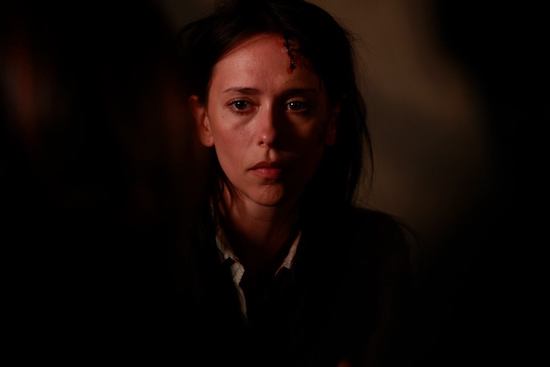
Jennifer Love Hewitt in “Behave.” (Photo credit: NBC.)
“Behave” (Written by: Jonathan Greene; Directed by: Helen Shaver): Arguably no hour of the series has made a larger societal impact than “Behave,” the third episode of the season.
In the episode, Benson and Stabler met Vicki, a repeated rape survivor who had been stalked by the same man since she was 16. Unfortunately, Vicki wasn’t his only victim: William Harris (James LeGros) had been raping women all over the country, and getting away with it due to the rape kit backlog. Benson traveled to multiple states in the hopes of finding a usable rape kit, but the only one that could work was still too degraded to be legally acceptable. Ultimately, they’re able to put William away due to evidence from one of the times he abducted Vicki.
Inspiration to dive into the real-life rape kit backlog—a cause that Hargitay has consistently championed in the nearly 14 years since the episode first aired—came from Baer attending a Joyful Heart dinner. (Hargitay founded Joyful Heart Foundation in 2004.)
“I sat next to this woman [Helena Lazaro] who was telling me her story about how she was afraid to leave her apartment,” Baer shares. “And I was like, ‘What do you mean?’ She told me…I knew what rape kits were, but I didn’t know about the untested kits. So I did some research, and I found out that Human Rights Watch had it as a big issue for them.”
“I use this in my teaching—I created a master’s degree program at Harvard Medical School in Media, Medicine, and Health, the first of its kind,” he continues. “And I show that episode…[there’s] a 30-second clip of Mariska hanging up the phone [saying], ‘15,000 cases in Detroit.’ And then she says at the end, ‘We’re telling the perps, they can get away with it, and we’re telling the victims they don’t matter.’”
“And so that episode was the start,” he continues. “I talked about data, emotion, action in my program. The data was finding out what’s going on, hearing that story. The emotion was the Jennifer Love Hewitt story [in the episode] to make it real. The action was partnering with Nick Kristof and Mariska and I wrote a piece for Huffington Post, and we went to Good Housekeeping. We did this whole kind of outreach in a new way. And we gave viewers a kit [to take action]…we had viewing parties, and they could go to their chief of police or city council members to demand that these [rape] kits be opened.”
In the years since it aired, “there’s been testimony; we testified,” Baer says. “Mariska’s testified more than I did. And she did her documentary I AM EVIDENCE. There are states that have cleared the backlog, and there are states that make it that they have to, by law, test them…So that was the beginning of the rape kit stuff. And that was by luck, good luck, that I’m sitting next to [Helena].”
“I just immediately knew,” he continues. “I remember saying to Mariska, ‘Oh my gosh, we’re going to do this amazing story.’ Then [Mariska] worked a lot with Human Rights Watch…It started a whole thing, and she’s still doing it. But that was the impetus.”
All these years later, “that’s probably one of the most important episodes, in terms of having clear policy impact,” Baer says. “There’s other shows, of course, but in terms of policy impact and actually seeing what happened after that…and the partnership [with] Nick Kristof [who] had, like, a million viewers [and did] lead out this 30-second piece, and said, ‘Every three minutes, someone is raped. Police don’t test that. The police departments don’t test.’ That’s been a cornerstone of my work about data, emotion, action. Like, it’s important to inform, but how do we take action? And people always were inspired by the show, so we gave them action by giving them their own kits to go to [demand change locally]. So I think that’s a very important show.”
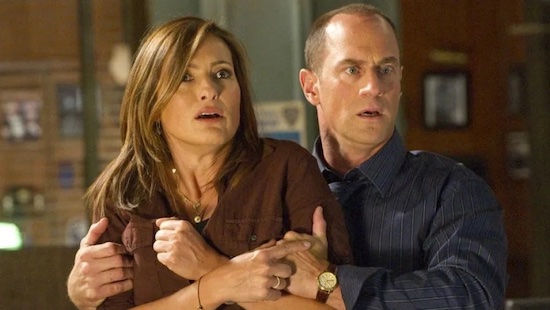
Hargitay and Meloni in a cut sequence. (Photo credit: NBC.)
“Merchandise” (Written by: Judith McCreary; Directed by: Peter Leto): Reuben returned as AUSA Christine Danielson as Benson and Stabler tried to get answers about why a young teen was starved—and killed by her equally malnourished and abused brother.
“Gloria Reuben is a very close friend of mine from ER—she’s been on before,” Baer says, referring both to the initial appearance of Christine in season 9, as well as her initial guest spot in season 4 (in a different role). “So she came back!” (Reuben also returned later in the season, too.)
But as the detectives were working the case, they had close-to-home problems, too: Their precinct was falling apart due to leaky pipes. In the following episode, they’ve made a home in a new precinct after the original one was destroyed beyond saving. However, in a cut final sequence, the squad room’s destruction was much more chaotic.
“It was a fire,” Baer shares. “I think it caught on fire first and then the pipes were bursting.”
Changing up the precincts aligned with the show’s real-life move from New Jersey to the New York City-set Chelsea Piers in the aftermath of LAW & ORDER’s 2010 cancellation. (Jersey’s tax credits also changed, too, upping the incentive.)
“Everybody was like, ‘Please move us to New York,’” Baer recalls. “So we just changed the set, and that’s the set they’re still on. But it made life so much easier for Mariska, for Chris, for everybody…that was a long trip to go out to [to the show’s initial stages]. We shot a lot in New Jersey [during its time there], and so it’s sad for New Jersey; they lost that. [But] good for New York City.”
As for why the fire-filled scene didn’t make it to air, “it just looked like s—,” Baer says with a laugh. “How do you burn the place down? It’s so hard to do that on a TV show. I mean, they do it on CHICAGO FIRE [now], but this was like, ‘How do you burn your set down?’ We tried.”
[Click here to read part 2, 3, and 4 of the series.]
LAW & ORDER: SPECIAL VICTIMS UNIT, Season Premiere, Thursday, October 3, 9/8c, NBC
RELATED:
- NBC Releases Key Art for LAW & ORDER, SPECIAL VICTIMS UNIT
- NBC Teases Maura Tierney’s LAW & ORDER Arrival and SVU Season 26 in New Promo
- LAW & ORDER: SPECIAL VICTIMS UNIT: Kelli Giddish to Guest Star in Season 26
- LAW & ORDER: SPECIAL VICTIMS UNIT: Brett Cullen to Guest Star in Season 26
- LAW & ORDER: SPECIAL VICTIMS UNIT: Juliana Aidén Martinez Will Be a Season 26 Series Regular
- LAW & ORDER: SPECIAL VICTIMS UNIT Officially Promotes Kevin Kane
- LAW & ORDER: SPECIAL VICTIMS UNIT: Peter Scanavino Reflects on His First Decade with the Series and His Season 26 Hopes
- LAW & ORDER: SPECIAL VICTIMS UNIT Season 25 Finale: ‘Duty to Hope’ Photos
- LAW & ORDER: SPECIAL VICTIMS UNIT: ‘Marauder’ Photos
- LAW & ORDER: SPECIAL VICTIMS UNIT: Peter Scanavino Previews Carisi’s ‘Conflicting Feelings’ About Rollins Consulting with the Squad
- LAW & ORDER: SPECIAL VICTIMS UNIT: NBC Teases the 550th Episode, ‘Marauder’
- LAW & ORDER: SPECIAL VICTIMS UNIT: ‘Combat Fatigue’ Photos
- LAW & ORDER: SPECIAL VICTIMS UNIT: Peter Scanavino Previews Carisi’s Attempt to Get Justice for Maddie
- LAW & ORDER: SPECIAL VICTIMS UNIT: ‘Children of Wolves’ Photos
- LAW & ORDER: SPECIAL VICTIMS UNIT: ‘Third Man Syndrome’ Photos
- NBC Renews ONE CHICAGO Trio, LAW & ORDER, and SVU
- LAW & ORDER: SPECIAL VICTIMS UNIT Recap: Did Olivia Reunite with Maria?
- LAW & ORDER: SPECIAL VICTIMS UNIT: Kelli Giddish to Return for Additional Season 25 Episode
- LAW & ORDER: SPECIAL VICTIMS UNIT: ‘Probability of Doom’ Photos
- LAW & ORDER: SPECIAL VICTIMS UNIT is Revisiting a Classic 2005 Episode
- LAW & ORDER: SPECIAL VICTIMS UNIT: USA Network Sets 25-Hour ’25 Reasons Why We Love SVU’ Marathon
- LAW & ORDER: SPECIAL VICTIMS UNIT: ‘Carousel’ Photos
- LAW & ORDER: SPECIAL VICTIMS UNIT Post-Mortem: Aimé Donna Kelly on What’s Next Post-Maddie and the Squad’s Newest Addition
- LAW & ORDER: SPECIAL VICTIMS UNIT: ‘Zone Rouge’ Photos
- LAW & ORDER: SPECIAL VICTIMS UNIT: Aimé Donna Kelly Previews Curry Joining the Squad and a New Break in the Maddie Case
- S. Epatha Merkerson on Sam Waterston’s LAW & ORDER Farewell and Her Hopes for a CHICAGO MED-SVU Crossover
- LAW & ORDER: SPECIAL VICTIMS UNIT: ‘Duty to Report’ Photos
- LAW & ORDER: SPECIAL VICTIMS UNIT: ‘The Punch List’ Photos
- LAW & ORDER: SPECIAL VICTIMS UNIT: ‘Truth Embargo’ Photos
- LAW & ORDER: SPECIAL VICTIMS UNIT Season 25 Cast Photos
- LAW & ORDER: SPECIAL VICTIMS UNIT: What You Need to Know About the Season Premiere
- LAW & ORDER: SPECIAL VICTIMS UNIT Season 25 Party Photos
- NBC Teases the Return of the LAW & ORDER Franchise with New Extended Promo
- LAW & ORDER: SPECIAL VICTIMS UNIT Adds Amy Carlson to Season 25
- NBC Teases the Season Premiere of ONE CHICAGO, LAW & ORDER Franchises
- NBC Releases New Key Art for LAW & ORDER, SVU, and ORGANIZED CRIME
- LAW & ORDER: SPECIAL VICTIMS UNIT: Kelli Giddish to Guest Star in Season 25 Premiere
- LAW & ORDER: SPECIAL VICTIMS UNIT: Allison Siko Looks Back on ‘Swing’
- LAW & ORDER: SPECIAL VICTIMS UNIT: Amanda Green Looks Back at Writing ‘Swing’ (Part 2)
- LAW & ORDER: SPECIAL VICTIMS UNIT: Amanda Green Looks Back at Writing ‘Swing’ (Part 1)
- LAW & ORDER: SPECIAL VICTIMS UNIT Season 24 Finale Recap: ‘All Pain Is One Malady’
- LAW & ORDER: SPECIAL VICTIMS UNIT Season 24 Finale: ‘All Pain Is One Malady’ Photos
- LAW & ORDER: SPECIAL VICTIMS UNIT’s Octavio Pisano Previews Velasco’s Team-Up with ORGANIZED CRIME’s Reyes
- LAW & ORDER: SPECIAL VICTIMS UNIT Recap: Carisi Spills a Secret, Benson and Stabler Reunite, and Muncy Gets a Win
- LAW & ORDER: SPECIAL VICTIMS UNIT: ‘Bad Things’ Photos
- 3 Teases for LAW & ORDER, SVU, and ORGANIZED CRIME
- LAW & ORDER: SPECIAL VICTIMS UNIT: ‘Debatable’ Photos
- LAW & ORDER: SPECIAL VICTIMS UNIT and ORGANIZED CRIME Set Three-Episode Crossover Finale Arc
- LAW & ORDER: SPECIAL VICTIMS UNIT Post-Mortem: Octavio Pisano on Velasco’s Big Decision and Proving His Loyalty to Benson
- LAW & ORDER: SPECIAL VICTIMS UNIT: Octavio Pisano Previews Velasco’s Reunion with Chilly
- NBC Renews LAW & ORDER, SVU, ORGANIZED CRIME, and ONE CHICAGO Trio
- LAW & ORDER: SPECIAL VICTIMS UNIT Scoop: A Case Hits Close to Home for Maxwell
- LAW & ORDER: SPECIAL VICTIMS UNIT Recap: What Secret Was Velasco Hiding?
- LAW & ORDER: SPECIAL VICTIMS UNIT: ‘King of the Moon’ Photos
- LAW & ORDER: SPECIAL VICTIMS UNIT: Mariska Hargitay Shares BTS Photos From ‘King of the Moon’
- The LAW & ORDER: SPECIAL VICTIMS UNIT Team Pays Tribute to Richard Belzer
- Cady McClain Dishes on Returning to LAW & ORDER: SPECIAL VICTIMS UNIT and DAYS OF OUR LIVES
- LAW & ORDER: SPECIAL VICTIMS UNIT Post-Mortem: Maurice Compte on Duarte and Olivia’s Different Approaches to Taking Down BX9
- LAW & ORDER: SPECIAL VICTIMS UNIT: Maurice Compte Previews Duarte’s Return to Take on BX9
- LAW & ORDER: SPECIAL VICTIMS UNIT: Octavio Pisano Teases Barba’s Return and an Unexpectedly Personal Scene Between Velasco and Carisi
- LAW & ORDER: SPECIAL VICTIMS UNIT: Pratibha Parmar on the ‘Real Gift’ of Making Her Network TV Directorial Debut with ‘Did You Believe in Miracles?’
- LAW & ORDER Stars Mariska Hargitay and Christopher Meloni Weigh in on a Potential Benson/Stabler Relationship: ‘It Just Has to be Earned’
- LAW & ORDER: SPECIAL VICTIMS UNIT: Warren Leight Explains the Cut Crossover Diner Scene
- LAW & ORDER: SVU and ORGANIZED CRIME: Mariska Hargitay and Christopher Meloni Break Down Olivia and Elliot’s Messy Reunion
Follow @GiveMeMyRemote and @marisaroffman on Twitter for the latest TV news. Connect with other TV fans on GIVE ME MY REMOTE’s official Facebook page or our Instagram.
And be the first to see our exclusive videos by subscribing to our YouTube channel.
As an Amazon Associate we earn from qualifying purchases made through links/ads placed on the site.
Related Posts
Filed under SVU
Comments Off on LAW & ORDER: SPECIAL VICTIMS UNIT Vet Neal Baer Looks Back on Season 12: ‘Locum,’ ‘Bullseye,’ ‘Behave,’ and ‘Merchandise’



Comments